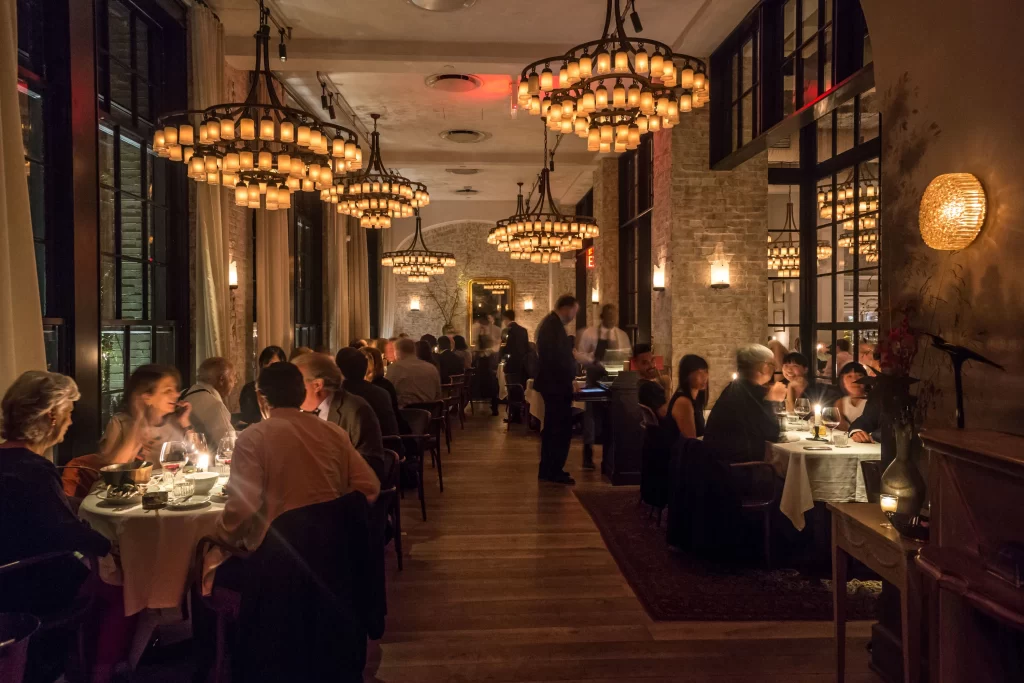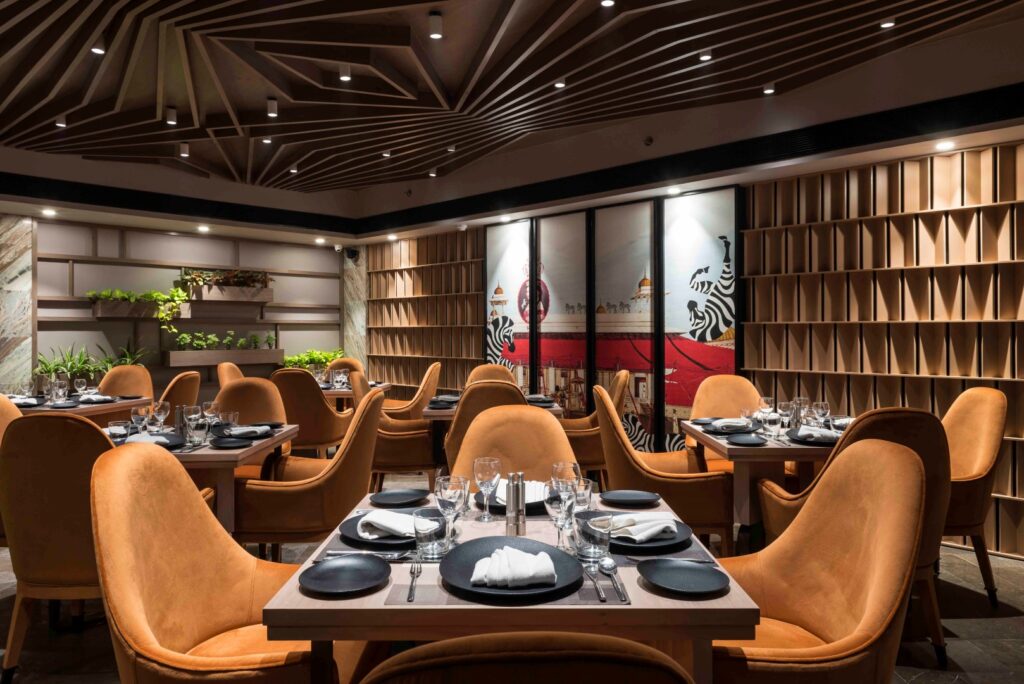Good food alone does not guarantee success, it is always a combination of food, service, ambience, rates and smooth operations that makes a restaurant successful. Most of us have had good dining experiences in restaurants where food was average but there was a certain good feeling and a sense of entertainment. Interior Design forms an important part in deciding how you want your customers to feel, what you want people to envision when they think about coming to your restaurant and what lasting impression they will take with them – one that will keep them coming back.
Designing a restaurant involves much more than choosing attractive furniture or a trendy theme. A well-designed restaurant interior is a harmonious blend of aesthetics, functionality, and comfort. Key elements such as the lighting, acoustics, furniture, music, and table settings, must be carefully considered to create an inviting and efficient space. Here are some general but essential points and tips to keep in mind when designing your restaurant.

General Design Tips
- Spend money on things that customers come into direct contact with such as tables, door handles, bathroom fixtures etc.
- Use durable materials.
- Do not Light space evenly! (more on it below)
- To hide ugly looking ceilings, use dark coloured paint and down lighting.
- Point light towards accent walls or decorative areas to draw people in the door.
- Prioritize your spending on the must-have features: AC, Lights, Accoustics, Furniture, Crockery & Cutlery. You can spend whatever is left over on the fine finishes and accents.
Let’s delve deeper into the different aspects or elements of Restaurant Design.
Concept and Theme
Consistency is crucial in restaurant design. Ensure that all design elements align with your restaurant’s concept or theme and brand. A cohesive design enhances the dining experience by creating a unified and appealing atmosphere. Whether you opt for a modern, rustic, or eclectic style, maintaining consistency in colors, materials, and decor is key. This also creates a brand perception in the mind of the customers and how they perceive your restaurant and what they associate it with.
Layout Design, Customer Flow and Accessibility
Your primary goal in layout and design is to figure out how to make the most profitable use of your space, while meeting customer’s expectations and ensuring smooth flow of operations. Design the layout to facilitate smooth movement for both customers and staff. The dining experience starts the moment a guest enters the door and not only are they influenced by the ambience but also by the ease of movement. Clear pathways and strategically placed furniture help avoid congestion and ensure that everyone can move comfortably. Additionally, ensure that your restaurant is accessible to all, including those with disabilities. This includes having ramps, wide doorways, and accessible restrooms.
Another consideration is that the distance between the kitchen and service station should be less so the servers are less fatigued and the no of servers needed by you will also decrease. Some experts suggest a ratio of 22 seats for each fully stocked service station. Also consider the potential need for reconfiguring spaces for different functions and events. Flexible furniture arrangements allow you to accommodate various group sizes, private events, and different dining scenarios. Movable tables and chairs can make it easy to transform your space as needed. Also read, Importance of SOPs for Restaurants
Lighting
Lighting plays a crucial role in setting the ambiance of your restaurant. Good lighting can not only affect the atmosphere and mood of the room but also customer’s sense of comfort and security. A well-lit room makes people look good which in turn makes them feel comfortable and relaxed. Use a combination of natural and artificial lighting to create a warm and inviting atmosphere. Maintain a balance between too bright and too dim without being boring. Dimmable lights are ideal for adjusting the brightness according to the time of day and the desired mood. Task lighting in the kitchen and bar areas ensures that staff can work safely and efficiently, while ambient lighting in the dining area enhances the overall dining experience. It is said that the higher the light levels the faster the turns on the table.

Acoustics
Managing noise levels is essential to creating a pleasant dining atmosphere. Use sound-absorbing materials like carpets, curtains, booths or chairs with well-padded backs, padded walls & tables and acoustic panels to reduce noise. This helps prevent the dining area from becoming too loud, allowing customers to enjoy their meals and conversations comfortably. In the bar area, consider sound management solutions, like ceiling treatments, to keep noise levels in check without stifling the lively atmosphere. If you have a large enough space then you can have to separate acoustic areas for different people who want to enjoy a calm environment or party with their friends.
Furniture
Choose durable, comfortable, and stylish furniture that aligns with your restaurant’s theme. Offer a mix of seating options, such as booths, tables, and communal dining areas, to cater to different group sizes and preferences. Comfortable seating encourages patrons to linger, enhancing their dining experience. The smaller and harder your seats will be the faster your customers will move along. Square and rectangular tables turn more frequently than round ones. Ensure that tables and chairs are arranged to offer enough space for comfort without wasting valuable floor area. Leave atleast 12 inches between seats and tabletops for easy movement of guests.

Music
Since the beginning of time, there have been emotional associations between eating, drinking and music. Select music that complements the restaurant’s atmosphere without overpowering conversations. The right music can enhance the ambiance and create a memorable dining experience for your customers. Consider the volume and type of music carefully to suit different times of the day and the overall vibe you want to create. It is generally observed that slow, relaxing music can raise tabs upto 40% as they make the customers want to drink and spend more.
Table Setting
Attention to detail in table settings can significantly enhance the dining experience. Use quality tableware, neatly folded napkins, and appropriate centerpieces to create an inviting and elegant setting. The table setting should reflect the restaurant’s theme and level of formality, whether it’s casual or upscale dining.

Aroma
Few people can resist the smell of a fresh pot of coffee brewing, fresh bread baking, or garlic and herbs sauteing in butter or oil. Yet, whenever restaurateurs think about smells in a restaurant they go for fragrances, diffusers, aroma candles etc. But one should remember how powerful and enticing the smell of good food cooking can be.
Kitchen Design
The kitchen is the heart of any restaurant, and its design should prioritize workflow efficiency, sanitation, and safety. A well-designed kitchen layout facilitates smooth movement and reduces the distance chefs and staff need to travel between stations. Ensure that the kitchen adheres to health and safety regulations, with proper ventilation, easy-to-clean surfaces, and strategically placed sinks. Adequate storage solutions help maintain organization and efficiency, while ergonomic considerations minimize physical strain on staff. Read in more details in WHY IS GOOD KITCHEN DESIGN VERY VITAL FOR A NEW RESTAURANT? and How Do Restaurant Consultants Provide Kitchen Consultancy ?
Bar Design
The bar area should be both functional and visually appealing. Position the bar so bartenders can serve both seated patrons and those waiting for tables efficiently. Incorporate under-bar refrigeration and ice bins for convenience. Use attractive materials and lighting to make the bar a focal point, and include a signature design element to make it memorable. Comfortable bar stools and chairs encourage patrons to linger, enhancing the overall experience.

Creating a Cohesive and Functional Space
The interior design of a restaurant significantly impacts the customer experience and operational efficiency. By focusing on the specific needs and characteristics of different areas and incorporating general design tips on lighting, acoustics, furniture, music, and table settings, you can create a cohesive and functional environment. Balancing style with functionality is the key to successful restaurant interior design, ensuring that your restaurant is not only visually appealing but also practical and comfortable for everyone who walks through the door. Hiring professionals or experts who are well versed with the technical aspects of a restaurant design and can guide you through the entire process is also necessary if you are just starting out. Read, When should a Restaurant hire a Restaurant Consultant?, Why Hire A Restaurant Consultant?. Hence, if you are planning to open your own restaurant, lounge, cafe etc do Contact DinerGuru for end-to-end consulting.
